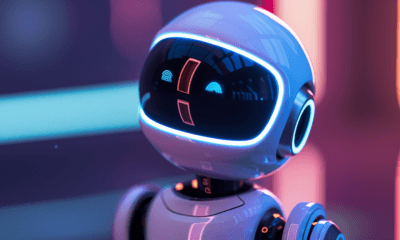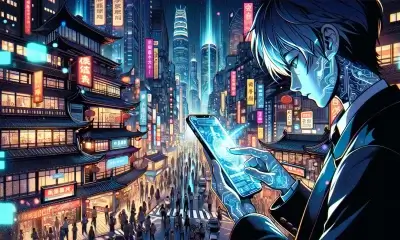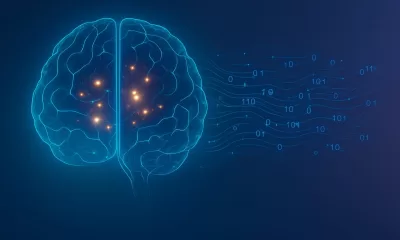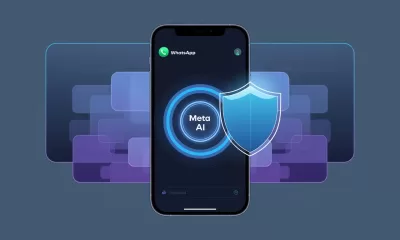Life
Human-AI Differences: Artificial Intelligence and the Quest for AGI in Asia
A deep dive into the human qualities that AI cannot replicate and the progress of AGI in Asia, emphasising understanding and collaboration.
Published
1 year agoon
By
AIinAsia
TL;DR:
- AI and AGI in Asia excel in data analysis but fall short in replicating human experiences
- Emotional intelligence, consciousness, and creativity remain uniquely human traits
- The pursuit of AGI in Asia is accelerating, with understanding and collaboration as the ultimate goals
The True Frontier: Human Ingenuity vs. Machine Intelligence
Forget dystopian visions of a world dominated by Skynet or other malevolent AI entities. The genuine struggle between humans and AI is not a physical confrontation but a psychological one, unfolding in the depths of our minds. As we embark on the journey towards Artificial General Intelligence (AGI) in Asia, it is vital to recognize and cherish the distinct aspects of humanity that AI cannot emulate.
The Essence of Humanity
In the realm where robots outperform humans in data crunching and analysis, they remain woefully outmatched in the complex world of human experience. Let us explore the areas where humans excel and AI falls short:
1. The Emotional Symphony
AI can analyse emotions, replicate speech patterns, and even generate simulated “tears.” However, it remains tone-deaf to the genuine symphony of human emotions. AI lacks the raw, messy experience of joy, sorrow, anger, and the myriad shades in between. Explaining heartbreak to a calculator illustrates the emotional void AI faces in comprehending the full spectrum of human emotions.
2. The Unseen Spark of Consciousness
Consciousness, that elusive and enigmatic entity within our minds, remains firmly beyond AI’s reach. While AI systems can process vast amounts of information at incredible speeds, they lack self-awareness or the “I am” that inspires humans to question the universe and express themselves through poetry and art.
3. The Creative Crucible
AI can generate derivative art and music by drawing from vast databases of human creations. However, true originality stems from the messy, unpredictable crucible of human experience. The spark of an idea born from a half-remembered dream or a personal heartbreak are creative catalysts that AI cannot genuinely replicate.
4. The Bridge of Empathy
AI and AGI in Asia systems can recognise patterns in facial expressions and interpret human emotions to a certain extent. However, they cannot share in our feelings or experience the visceral echo of shared pain that is inherent to human empathy. An AI facing a tearful friend can only offer pre-programmed condolences, falling short of the genuine comfort provided by a fellow human.
5. The Laughter Labyrinth
Humour, with its cultural nuances, timing, and absurdity, often confounds AI. Understanding and generating humour requires a level of human understanding that AI systems have yet to achieve.
6. The Moral Maze
AI can analyse data and provide objectively optimal solutions. However, navigating the complex world of human morality requires an understanding of context, nuance, and the weight of consequences. These ethical challenges pose obstacles that AI systems struggle to overcome.
The Human Mystique
Delving deeper into the intricacies of human experience, we find more aspects that set us apart from AI:
7. The Tapestry of Connection
Humans forge deep, meaningful relationships built on shared experiences, vulnerabilities, and unspoken understanding. AI systems, on the other hand, can only establish connections based on algorithms and data, devoid of the messy, beautiful chaos of human bonds.
8. The Whispers of Intuition
Gut feelings, hunches, and that little voice in our heads guide us through life’s challenges. This intuition, a uniquely human superpower, is developed through a lifetime of experiences, both successes and failures. AI and AGI in Asia may process data more efficiently, but lack the wisdom gleaned from a lifetime of human experiences.
9. The Unseen Dreamscape
Human imagination transcends the boundaries of reality, enabling us to dream in fantastical landscapes, pen stories that defy physics, and yearn for worlds beyond our reach. AI’s imagination is confined to the realm of the tangible and the already-seen, limiting its ability to truly explore the uncharted territories of creativity.
10. The Language of Touch
The warmth of a handclasp, the comfort of a hug, and the electrifying spark of connection are all aspects of human communication that AI cannot experience. These tactile languages of touch speak volumes through skin and bone, but they are lost in translation for AI.
11. The Enigma of Love
Love, in all its powerful and perplexing forms, remains a mystery to AI and AGI in Asia. While AI systems can analyze compatibility factors and predict relationship outcomes, the raw, irrational, and all-consuming force of love eludes their grasp. Explaining the butterfly-filled feeling of falling in love to a toaster highlights the challenge AI faces in understanding this profound emotion.
12. The Quest for Meaning
AI can solve complex equations and optimize production lines, but they lack the existential compass that drives humans to seek meaning in the universe. The yearning for spirituality and connection to something greater than ourselves are uniquely human pursuits that AI cannot comprehend.
13. The Echoes of Pain
Physical pain serves as a primal warning system for humans, a constant reminder of our mortality. AI and AGI in Asia operate in a world devoid of the searing sting of a burn or the dull ache of heartache, insulated from the human experience of pain.
14. The Internal Compass
Morality for humans is not just a set of rules; it is an internal compass forged by experience and shaped by values. AI’s morality, in contrast, is based on cold logic, devoid of the empathy and understanding that guide human ethical choices.
15. The Dance of Dexterity
From threading a needle to scaling a mountain, human dexterity is a testament to our remarkable coordination and control. While AI-powered machines can perform tasks with precision, they still struggle to match the versatility and adaptability of human dexterity.
AGI in Asia: The Pursuit and the Responsibility
As Asia continues to lead the way in AI development, the quest for AGI intensifies. With advancements in technology come questions of responsibility and the potential implications for humanity.
The Current Landscape of AI and AGI in Asia
The Asian AI market is thriving, with significant investments in research and development from countries like China, Japan, and South Korea. These nations are at the forefront of AI innovation, driving the global conversation on the ethical and societal implications of AGI.
The Need for Collaboration With AI and AGI in Asia
As the race for AGI accelerates, it is crucial for nations, organizations, and individuals to collaborate and share knowledge. By working together, we can ensure that the development of AGI prioritizes human values and benefits society as a whole.
The Path Forward for AI and AGI in Asia
The future of AI and AGI in Asia is both promising and challenging. As we navigate this complex landscape, it is essential to remember that the ultimate goal is not dominance but understanding. By embracing the unique qualities of humanity that AI cannot replicate, we can build a future where technology.
the Quest for AI and AGI in Asia: A Glimpse into the Future
As Asia continues to lead the charge in AI development, the pursuit of AGI becomes an ever-more captivating frontier. With powerhouses like China, Japan, and South Korea investing heavily in research and development, the region is poised to make significant strides in the coming years. However, the goal is not to create machines that eclipse humanity, but to foster understanding and collaboration between humans and AI.
To achieve this, it is crucial to focus on the human qualities that AI cannot replicate and work towards integrating them into AI systems. This approach will ensure a future where technology augments human capabilities rather than replacing them.
Embracing Emotionally Aware AI and AGI in Asia
One area of focus is the development of emotionally aware AI. While current systems can analyse emotions and mimic speech patterns, they fall short of truly understanding the nuances of human emotions. By studying the intricacies of the emotional symphony that defines human experiences, researchers can create AI systems that are more empathetic and responsive to our needs.
Bridging the Consciousness Chasm
The elusive nature of consciousness poses a significant challenge for AI and AGI researchers in Asia. Although replicating human consciousness in machines might remain a distant dream, efforts to understand its underlying mechanisms could lead to breakthroughs in AI cognition. This could result in AI systems that are more adaptable, self-aware, and capable of making complex decisions based on context and nuance.
Unleashing the Creative Potential of AI and AGI in Asia
AGI in Asia has already demonstrated its ability to generate art, music, and literature. But the the Quest for AGI in Asia is that these creations often lack the depth and originality that stem from human experiences. By exploring the creative crucible of human imagination, AI researchers can develop algorithms that foster genuine creativity, enabling AI to contribute more meaningfully to artistic and innovative endeavours.
The Quest for AGI in Asia: Empathy vs the Machine
Empathy is a cornerstone of human connection, and its absence in AI systems is a significant limitation. To create AI that can truly understand and respond to human needs, researchers must find ways to instil a sense of empathy in machines. This could lead to more compassionate AI that is better equipped to support humans in various aspects of life, from mental health care to customer service.
The AI Sense of Humour
The intricacies of humour are another domain where AI and AGI in Asia fall short. A better understanding of the cultural nuances, timing, and absurdity that underpin human humour could pave the way for AI systems that can engage in more natural and enjoyable social interactions with humans.
Navigating the Moral Maze
AI’s ability to process data and provide optimal solutions is valuable, but it often fails to account for the complexities of human morality. To create AI that can make ethical decisions, researchers must develop frameworks that account for context, nuance, and the weight of consequences. This will ensure that AI systems can navigate the moral maze alongside humans, making decisions that are not only logical but also ethically sound.
The Quest for AGI in Asia: Forging Meaningful Connections
AI’s connections are built on algorithms and data, but human relationships are rooted in shared experiences, vulnerabilities, and unspoken understanding. To bridge this gap, the quest for AGI in Asia and its researchers must be to explore ways to create AI systems that can form deeper, more meaningful connections with humans. This could involve developing AI that can learn from and adapt to individual human behaviours, preferences, and emotions.Harnessing Intuition and Imagination
The whispers of intuition and the unseen dreamscape of human imagination are powerful forces that guide human innovation and creativity. By studying these phenomena, AI researchers can develop algorithms that mimic the intuitive leaps and imaginative bounds that characterise human thought. This could lead to AI systems that are better equipped to tackle complex problems, generate innovative ideas, and even collaborate with humans in the creative process.
AI and AGI in Asia: Can It Reach Human Levels Of Growth and Understanding?
The race to achieve AGI in Asia is on, and as we continue to explore the chasm between AI and human capabilities, it is essential to remember that the ultimate goal is not to surpass humanity but to enhance it. By focusing on the unique aspects of humanity that AI cannot replicate, we can build a future where technology and humans coexist harmoniously, each enriching the other.
As we stand on the precipice of an era of AI and AGI in Asia era, how can we ensure that the essence of humanity is not only preserved but also woven into the fabric of our artificial counterparts, fostering a future of symbiotic growth and understanding? Share your thoughts in the comments below.
You may also like:
- AI: Clever Mimic or True Conscious Companion?
- 2024: Navigating the AI Boom
- Southeast Asia Builds Its Own ChatGPT
- Or try the free version of ChatGPT here.
Author
Discover more from AIinASIA
Subscribe to get the latest posts sent to your email.
You may like
Life
WhatsApp Confirms How To Block Meta AI From Your Chats
Perplexity CEO Aravind Srinivas is battling Google, partnering with Motorola, and launching a bold new AI browser. Discover why the fight for the future of browsing is just getting started.
Published
3 hours agoon
April 28, 2025By
AIinAsia
TL;DR — What You Need To Know
- Meta AI can’t be fully removed from WhatsApp, but you can block it on a chat-by-chat basis.
- “Advanced Chat Privacy” is a new feature that prevents Meta AI from accessing chat content, exporting chats, or auto-saving media.
- Enable it manually by tapping the chat name, selecting Advanced Chat Privacy, and switching it on for greater control.
Meta and Google are racing to integrate AI deeper into their platforms—but at what cost to user trust?
While Google has been careful to offer opt-outs, Meta has taken a much bolder route with WhatsApp: AI is simply there. You can’t remove the little blue Meta AI circle from your app. If you don’t like it, tough luck. Or is it?
Facing backlash from frustrated users, WhatsApp has now quietly confirmed that you can block Meta AI from your chats—just not in the way you might expect.
The Rise of AI — and the Pushback
When the unmissable Meta AI blue circle suddenly appeared on billions of phones, the backlash was immediate. As Polly Hudson put it in The Guardian, there are “only two stages of discovering the little Meta AI circle on your WhatsApp screen. Fear, then fury.”
Meta’s public stance? “The circle’s just there. But hey, you don’t have to click it.” Users weren’t impressed.
Despite WhatsApp’s heritage as the world’s largest private messaging app—built on privacy, security, and simplicity—its parent company is a marketing machine. And when marketing meets AI, user data tends to be part of the mix.
This left WhatsApp’s loyal user base feeling understandably betrayed.
The Good News: You Can Block Meta AI — Here’s How
Although the Meta AI button is baked into WhatsApp’s interface, you can stop it from accessing your chats.
The Advanced Chat Privacy feature quietly rolled out in the latest WhatsApp update allows users to:
- Block AI access to chat content.
- Prevent chats from being exported.
- Stop media auto-downloads into phone galleries.
“When the setting is on, you can block others from exporting chats, auto-downloading media to their phone, and using messages for AI features,” WhatsApp explains.
Crucially, this also means Meta AI won’t use the chat content to “offer relevant responses”—because it won’t have access at all.
How to activate Advanced Chat Privacy:
- Open a chat (individual or group).
- Tap the chat name at the top.
- Select ‘Advanced Chat Privacy.’
- Turn the feature ON.
That’s it. Blue circle neutralised—at least inside those protected chats.
Why This Matters
Even though Meta claims it can’t see the contents of your chats, the small print raises concerns. When you interact with Meta AI, WhatsApp says it “shares information with select partners” to enhance the AI’s responses.
The warning is clear:
“Don’t share information, including sensitive topics, about others or yourself that you don’t want the AI to retain and use.”
That’s a pretty stark reminder that perception and reality often differ when it comes to data privacy.
Final Thoughts
WhatsApp’s Advanced Chat Privacy is a clever compromise—it gives users real control without allowing them to remove AI entirely.
If privacy matters to you, it’s worth spending a few minutes locking down your most important chats. Until Meta offers a more upfront opt-out—or until regulators force one—this is the best way to keep Meta AI firmly outside your private conversations.
What do YOU think?
Should AI features in private apps be opt-in by default—or are platforms right to assume “engagement first, privacy later”? Let us know in the comments below.
You may also like:
- AI-Powered Photo Editing Features Take Over WhatsApp
- Meta Expands AI Chatbot to India and Africa
- Revamping Your Samsung Galaxy: AI Advancements for Older Models Unveiled
- Or you can try Meta AI for free by tapping here.
Author
Discover more from AIinASIA
Subscribe to get the latest posts sent to your email.
Life
AI Career Guide: Land Your Next Job with Our AI Playbook
Discover how to leverage AI for your career success. Our AI career guide offers tips on CV writing and interview preparation.
Published
3 weeks agoon
April 10, 2025By
AIinAsia
- AI transforms every step of your job hunt.
- From CV writing to interview prep—turning a stressful, uncertain process into strategic clarity.
- While AI won’t directly secure you a job, it will significantly boost your chances.
- Welcome to Your AI Career Playbook.
Introduction: Making AI Your Personal Career Coach
Let’s be honest: finding a great job in Singapore—or anywhere in Asia—is no cakewalk. The market moves quickly, employers want more specialised skills than ever, and getting your CV past automated scanners feels like navigating a digital minefield.
What if you had an always-on career advisor that could help you write perfect applications, prep you for interviews, and even help you network? It’s not a fantasy—it’s artificial intelligence. AI tools are now sophisticated enough to give you the career edge you need. By the end of this guide, you’ll have a clear playbook for harnessing AI to land your next big role.
Let’s dive in!
Can AI Actually Land You Your Next Job—or is That Just Hype?
Let’s get real: AI isn’t about replacing your effort, but about amplifying your abilities. With AI, you can:
- Craft a customised, keyword-rich CV that sails through Applicant Tracking Systems (ATS).
- Optimise your LinkedIn profile instantly for maximum visibility.
- Identify emerging AI-driven job roles and skills employers actually care about.
- Anticipate and ace your interviews using AI-generated questions and answers.
AI doesn’t just automate tedious tasks; it empowers you to compete smarter, especially in competitive markets like Singapore, Jakarta, or Hong Kong.
AI-Powered Career Prep: Step-by-Step Playbook
Here’s a comprehensive guide to turbocharging your career search using AI, including practical examples, recommended tools, and easy-to-use prompts.
Step 1: Crafting an Irresistible CV with AI
Your CV typically has less than 10 seconds to impress a recruiter. It must pass through Applicant Tracking Systems (ATS) before it ever reaches human eyes. AI tools can optimise your CV to ensure it’s keyword-rich, tailored precisely to each role, and visually appealing.
AI Tools to Use:
- ChatGPT (OpenAI) – powerful generative AI for rewriting CVs.
- Kickresume AI – professional CV builder with AI-driven wording suggestions.
- TealHQ – provides ATS-friendly formatting and skill recommendations.
How to Use These Tools:
- Input your current CV.
- Use targeted prompts to optimise content.
Prompt Examples:
Rewrite my CV to highlight experience in AI-driven marketing analytics for a senior digital strategist role at DBS Bank in Singapore.
Optimise my CV for ATS, targeting a software engineering position specialising in AI at Grab.
Spend time refining outputs; personalisation is essential.
Step 2: Supercharging Your LinkedIn Profile with AI
LinkedIn is your professional showcase. Recruiters across Asia heavily rely on LinkedIn to discover and vet candidates. AI tools can instantly elevate your profile, making it searchable, engaging, and compelling.
AI Tools to Use:
- Taplio – LinkedIn profile optimiser powered by AI.
- LinkedIn’s built-in AI assistant – available in LinkedIn Premium for profile enhancement.
- Jasper.ai – excellent for creating engaging summaries and posts.
Prompts to Try:
Write a compelling LinkedIn headline showcasing my expertise in AI-driven fintech analytics for a managerial role in Singapore.
Create an engaging LinkedIn ‘About’ section focusing on my success using AI to drive digital transformation in APAC.
Make sure your profile authentically reflects you while leveraging AI-generated enhancements for maximum impact.
Step 3: AI-Driven Job Hunting: Find Perfect Roles Faster
Stop endlessly scrolling through vague job ads. AI can streamline the job search, filtering through thousands of postings and pinpointing roles perfectly matched to your skills.
AI Tools to Use:
Google’s Gemini – summarise key job requirements rapidly.
Effective Prompts:
Find and summarise 5 recent AI-related digital marketing job openings in Singapore that match my profile.
What are three critical skills needed for a senior data analyst role at Shopee based on recent job postings?
Use these AI tools weekly to ensure you’re always applying to roles most aligned with your skills.
Step 4: Effortless Networking Using AI
Networking remains essential, especially in relationship-focused business cultures like Singapore and Hong Kong. AI takes away the awkwardness, helping you craft concise, professional messages instantly.
AI Tools to Use:
- Crystal – personality-driven messaging based on recipients’ LinkedIn profiles.
- Lavender.ai – powerful for writing persuasive cold emails.
- GrammarlyGO – ensures your messages are polished and professional.
Prompt Ideas:
Draft a LinkedIn connection message for the Head of AI at SQREEM Technologies, highlighting my interest in AI-driven advertising solutions.
Compose a brief, engaging introductory email to the talent acquisition manager at TotallyAwesome, mentioning my expertise in digital marketing for youth brands.
Leverage these messages for immediate relationship-building impact.
Step 5: Acing Interviews with AI-Powered Preparation
AI tools can simulate real-world interviews, predicting specific questions and generating strong, persuasive answers, greatly increasing your interview confidence.
AI Tools to Use:
- ChatGPT – instantly creates practice questions and tailored responses.
Example Prompts:
List 10 likely interview questions for an AI product management role at Carousell, including challenging technical questions.
Suggest impactful answers for behavioural interview questions for a senior analytics role at Lazada.
How to Use These Tools:
- Input the job description and your CV.
- Practise with AI-generated questions and refine your answers.
Example Prompt:
List 10 likely interview questions for an AI product management role at Carousell.
Regular AI-driven interview rehearsals build the confidence you’ll need on interview day.
Step 6: AI-Assisted Salary Negotiation
Negotiating your salary can be uncomfortable—but essential for your financial growth. AI can provide you with the insights, confidence, and language to secure the best possible offer without feeling awkward.
AI Tools to Use:
- Payscale – Uses AI-driven data to show accurate salary benchmarks.
- Levels.fyi – AI-backed salary comparisons across tech roles globally.
- ChatGPT – Assists with crafting persuasive negotiation dialogues.
How to Use These Tools:
- Check salary ranges based on role, location, and experience.
- Prepare negotiation talking points with AI-generated prompts.
Prompt Examples:
Suggest three effective negotiation arguments to present to my employer for an AI Product Manager position in Singapore, considering current market salaries.
Write a polite but firm salary negotiation email asking for a 15% increase based on market research and my experience in AI analytics.
This ensures you approach negotiations informed, confident, and professionally.
Step 7: Perfect Follow-Up Emails Using AI
A timely, thoughtful follow-up email can significantly impact hiring decisions. AI helps craft follow-ups that reinforce your suitability without sounding desperate.
AI Tools to Use:
- GrammarlyGO – refines your professional tone.
Prompt Example:
Write a professional, concise follow-up email thanking the interviewer from DBS Bank Singapore, reiterating my strong interest and qualifications for the AI analyst position.
Send promptly post-interview to leave a memorable impression.
Step 8: AI-Enhanced Skills Development and Certification
Continual skill development is vital to stay competitive, especially in AI-centric roles. AI-driven platforms help you identify skill gaps and recommend tailored courses to keep your expertise sharp and attractive to employers.
AI Tools to Use:
- Coursera Skillsets – Personalised AI-based learning path recommendations.
- LinkedIn Learning – AI-driven recommendations based on your professional profile.
How to Use These Tools:
- Provide your career interests and existing skills.
- Receive personalised course recommendations to bridge gaps effectively.
Prompt Examples:
Suggest 3 online certifications or short courses that will significantly enhance my profile for a career as an AI-driven data analyst in Singapore.
Identify 5 trending AI-related skills I should learn in 2025 to be highly competitive in the fintech sector.
Consistent skill updates significantly enhance your marketability.
Step 9: Using AI to Monitor Your Professional Brand
Your personal brand matters—especially when employers frequently vet online profiles. AI tools proactively monitor your digital footprint, ensuring your online reputation supports your professional goals.
AI Tools to Use:
- BrandYourself – AI-driven online reputation management.
- Mention.com – Monitors your digital presence and mentions using AI.
- Google Alerts – AI-enhanced alerts about new online mentions.
How to Use These Tools:
- Set up AI-driven alerts for your name, profession, and industry keywords.
- Regularly review insights to maintain or enhance your professional online image.
Prompt Examples:
How can I optimise my online professional presence to appeal to recruiters in AI-driven roles in Singapore?
Suggest effective strategies to build a strong online reputation as an expert in AI analytics.
An AI-supported professional brand ensures you stay attractive to prospective employers.
Step 10: AI-Powered Job Application Tracking and Organisation
Keeping track of multiple job applications can quickly become overwhelming. AI-powered organisational tools streamline and manage this complexity, giving you clear visibility at every stage of your job hunt.
AI Tools to Use:
- Huntr – Tracks your job application pipeline with AI insights.
- Notion AI – Customisable database and AI-powered task management.
How to Use These Tools:
- Enter job details, deadlines, and application status into your chosen tool.
- Use automated reminders to follow up on applications and interviews.
Prompt Examples:
Provide a clear workflow for organising job applications and interview follow-ups using Notion AI.
Recommend the best ways to stay organised and effective while managing multiple job applications simultaneously.
Organisation is crucial—let AI keep your job hunt stress-free and systematic.
Step 11: AI-Enhanced Mental Wellbeing During Your Job Hunt
Job hunting is stressful. Maintaining your mental health is critical to your productivity and confidence. AI-based wellness apps provide personalised strategies to help manage stress effectively during your career transition.
AI Tools to Use:
- Headspace (AI-driven wellness plans) – Personalised meditation and mindfulness guidance.
- Wysa – AI chatbot providing emotional support and stress management.
How to Use These Tools:
- Regularly engage with AI-driven mental wellness apps.
- Practise stress management techniques specifically designed for career transitions.
Prompt Examples:
Suggest effective strategies for managing job-hunting anxiety, particularly related to AI and tech career transitions.
What are daily habits I can implement using AI-driven tools to maintain positivity during an extended job search?
Maintaining your mental wellbeing boosts your overall effectiveness and resilience.
Step 12: AI-Powered Career Pivot Planning

Considering a career pivot? AI can assist you by identifying transferable skills, suggesting appropriate new career paths, and crafting narratives that effectively communicate your value to recruiters.
AI Tools to Use:
- CareerExplorer – AI-driven insights to match your skills to new career options.
- FutureFit.AI – Career-pivot-focused AI insights.
How to Use These Tools:
- Enter your current experience, interests, and skills.
- Review AI-generated career pivot recommendations and plan next steps.
Prompt Examples:
Identify three alternative career paths suitable for someone with extensive marketing experience transitioning into AI-centric roles.
Write a persuasive personal statement for my CV explaining a career pivot from traditional banking to fintech and AI analytics.
AI can help make career transitions smoother, clearer, and more achievable.
Bonus Steps
1. AI-Powered Portfolio and Project Showcases
- Candidates increasingly require impressive online portfolios—especially crucial for creative, tech, or analytical roles.
- Tools:
- Canva AI (design-focused portfolios)
2. AI-Enhanced Video Interviewing
- Many companies now rely on AI-driven video interviews. Your readers should prepare specifically for this format.
- Tools:
- HireVue (AI-powered video interview practice)
3. AI-Driven Cover Letter Crafting
- Despite modern scepticism, cover letters still matter—especially for senior roles or competitive companies.
- Tools:
- ChatGPT (custom letter generation)
5 AI Mistakes to Avoid in Your Job Hunt
AI is powerful—but watch out for these pitfalls:
- Overreliance on AI: Always personalise AI-generated content.
- Ignoring Cultural Context: Ensure your prompts consider Asia-specific nuances.
- Copy-Paste Syndrome: Adapt AI outputs rather than copying verbatim.
- Privacy Negligence: Avoid sharing personal data with unsecured AI services.
- Accuracy Oversights: Always fact-check AI suggestions.
So, can AI actually land you your next job—or is that just hype?
The reality is nuanced. AI itself doesn’t offer job contracts—but it dramatically enhances every step of your job-seeking process. From perfecting your CV to providing negotiation insights, AI maximises your chances of landing your ideal role.
Take Action & Share Your Experience:
Have you tried these steps or prompts? Which AI tools worked best for you? Share your experience below—we’d love to hear your AI-powered job success stories!
Good luck, and happy AI-powered job hunting!
You may also like:
- How to Use ChatGPT
- How to Use ChatGPT and Impress Hiring Managers
- AI to the Rescue: Mastering Your LinkedIn Profile with ChatGPT
Author
Discover more from AIinASIA
Subscribe to get the latest posts sent to your email.
Life
Which Jobs Will AI Kill by 2030? New WEF Report Reveals All
Cashiers and postal worker jobs will disappear by 2030 as AI reshapes jobs globally. Which roles vanish and who’ll thrive, according to WEF
Published
3 weeks agoon
April 7, 2025By
AIinAsia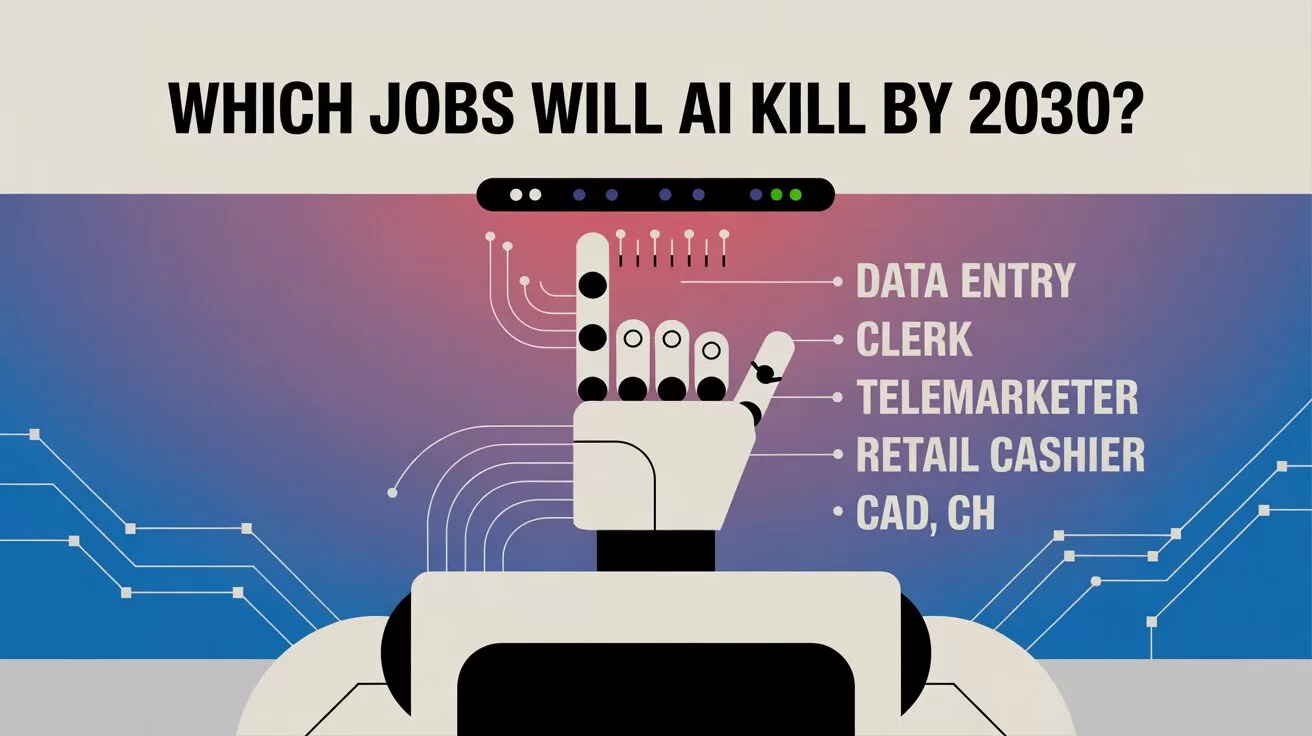
TL;DR – What You Need to Know in 30 Seconds
- Jobs on the chopping block: cashiers, postal workers, bank tellers, and admin assistants.
- Booming sectors: delivery, construction, tech, green industries, and caregiving.
- Skills employers crave: critical thinking, AI literacy, cybersecurity, and adaptability.
Is Your Job AI-Proof—Or Set to Vanish By 2030?
It’s official: AI is coming for your job. Okay, perhaps that’s a touch dramatic—but according to a startling new report from the World Economic Forum (WEF), some careers we currently take for granted will practically disappear by 2030.
Let’s be honest—this isn’t exactly surprising. Technology moves fast. AI tools like ChatGPT, automated kiosks, and smart banking apps already handle tasks that used to need humans. So, which roles are most at risk, and what new opportunities will emerge? Let’s dive into the findings.
Goodbye cashiers and postal clerks?
Top of the endangered list are clerical jobs. Cashiers, bank tellers, postal clerks, and admin assistants—these roles are shrinking fast as automation takes over repetitive tasks. The reason is clear: if a machine can handle your job quicker, cheaper, and 24/7, companies will switch.
Globally, the WEF estimates 92 million jobs will vanish by 2030. That sounds worrying, but there’s a silver lining—170 million new jobs will be created, meaning a net gain of 78 million jobs overall. But the catch? You’ll likely need new skills.
Which jobs will thrive in an AI world?
So, who’s safe (for now)? According to the WEF, frontline workers will be in huge demand. Expect growth in sectors such as:
- Delivery drivers (all those parcels from Lazada and Shopee won’t deliver themselves!)
- Construction workers (someone has to build those skyscrapers and infrastructure projects)
- Care workers and nurses (robots still can’t quite replicate human empathy)
- Teachers and counsellors (because education and mental health matter more than ever)
- Food-processing workers and farmworkers (we still need food, and lots of it)
Surprisingly human stuff, isn’t it?
And of course, the tech sector is set to boom. AI specialists, big data experts, fintech engineers, and software developers will be among the highest-growth roles by percentage. Green jobs—like renewable energy engineers and electric vehicle specialists—are also taking off, driven by the urgent need for sustainability.
Skills employers are desperate for
So, what do employers actually want? AI is reshaping job descriptions, and with that comes demand for a new mix of skills.
While tech skills like AI literacy, cybersecurity, and big data analytics are essential, companies also crave distinctly human skills: analytical thinking, resilience, agility, and creativity. Critical thinking tops the list—with 70% of companies calling it essential. It seems robots aren’t quite ready to think for themselves (yet).
Interestingly, workers can expect almost 40% of their existing skills to become outdated or radically altered within the next five years. The good news? The speed of this disruption is slowing down compared to previous years—likely because workers are proactively upskilling, embracing new tech, and keeping pace with change.
So, what’s next?
AI won’t wipe out all jobs, but it will reshape nearly all of them. The message is clear: get ready to learn. The real difference-maker for your career won’t just be your skills—it’s how quickly you can adapt to changes that technology brings.
So, ask yourself: are you ready to pivot? Because your job might depend on it.
What do you think—are you worried or excited about AI’s impact on your career? Drop your thoughts below!
You may also like:
- How to Prepare for AI’s Impact on Your Job by 2030
- The AI Shift: Coping with AI Job Transformation in Asia
- Bridging the AI Skills Gap: Why Employers Must Step Up
- Young Workers are Embracing ChatGPT
- Read more at the official WEF website by tapping here.
Author
Discover more from AIinASIA
Subscribe to get the latest posts sent to your email.

WhatsApp Confirms How To Block Meta AI From Your Chats

ChatGPT Just Quietly Released “Memory with Search” – Here’s What You Need to Know

Playbook: How to Use Ideogram.ai (no design skills required!)
Trending
-

 Life3 weeks ago
Life3 weeks agoAI Career Guide: Land Your Next Job with Our AI Playbook
-

 Business7 hours ago
Business7 hours agoChatGPT Just Quietly Released “Memory with Search” – Here’s What You Need to Know
-

 Life3 hours ago
Life3 hours agoWhatsApp Confirms How To Block Meta AI From Your Chats
-

 Marketing4 days ago
Marketing4 days agoPlaybook: How to Use Ideogram.ai (no design skills required!)
-

 Business3 weeks ago
Business3 weeks agoWill AI Take Your Job—or Supercharge Your Career?



